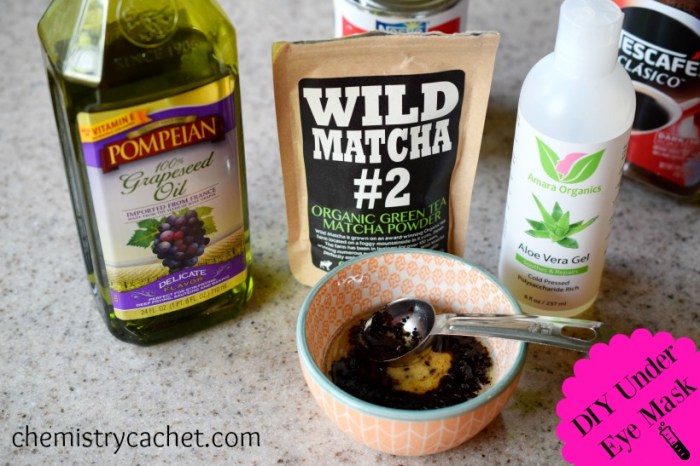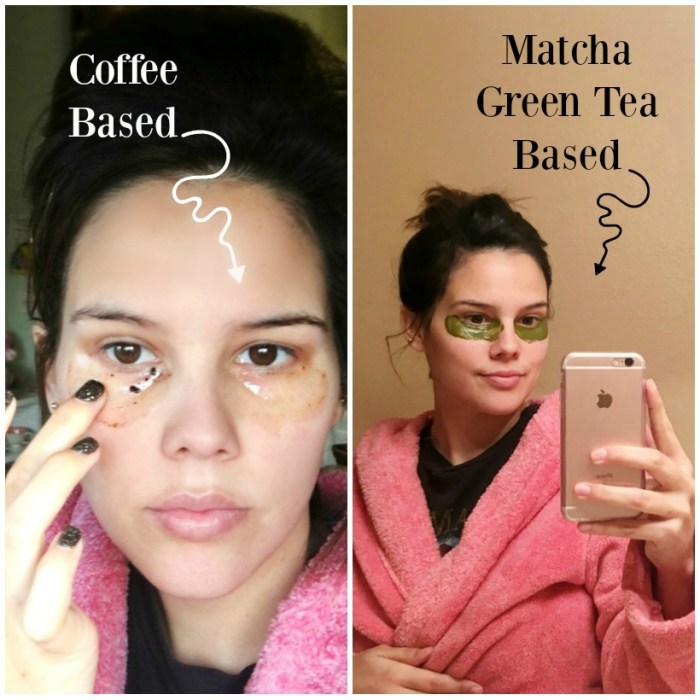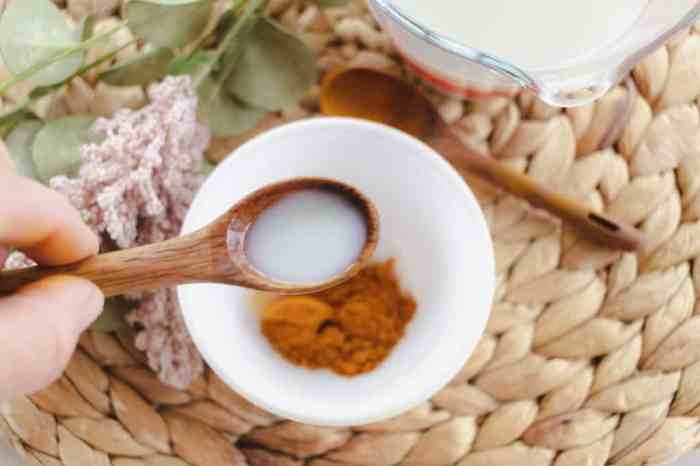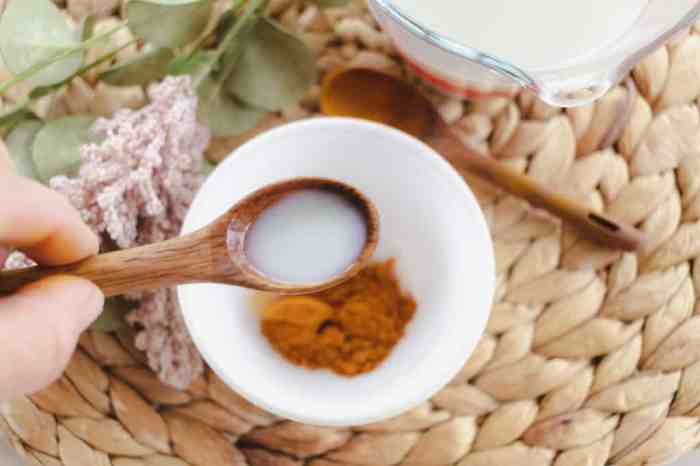DIY under eye masks offer a natural and affordable way to address common under-eye concerns like dark circles, puffiness, and wrinkles. These simple homemade remedies leverage the power of readily available ingredients to nourish and revitalize the delicate skin around your eyes.
From soothing cucumber slices to hydrating avocado, a world of possibilities awaits those seeking a natural approach to enhancing their eye area. Whether you’re aiming for brighter, smoother, or simply more rested-looking eyes, there’s a DIY under eye mask recipe out there for you.
DIY Under Eye Mask Ingredients
Treating under-eye concerns can be a part of your skincare routine. DIY under-eye masks can be a cost-effective way to address specific issues. These masks can be made using readily available ingredients that offer various benefits for the delicate skin around the eyes.
Benefits of Common Ingredients
Common ingredients used in DIY under-eye masks provide a range of benefits for the skin.
- Cucumber: Its cooling and hydrating properties help reduce puffiness and dark circles.
- Aloe vera: Known for its anti-inflammatory and soothing properties, it helps reduce redness and irritation.
- Green tea: Rich in antioxidants, it helps protect the skin from damage and reduce dark circles.
- Potato: Its natural bleaching properties can help lighten dark circles and brighten the skin.
- Milk: Contains lactic acid, which helps exfoliate and brighten the skin, reducing the appearance of dark circles.
- Honey: A natural humectant, it helps moisturize and nourish the skin, reducing dryness and fine lines.
- Coconut oil: Rich in fatty acids, it helps moisturize and nourish the skin, reducing dryness and wrinkles.
- Avocado: Contains vitamins A, C, and E, which help nourish and protect the skin from damage.
DIY Under Eye Masks for Specific Concerns
Here are some DIY under-eye mask recipes targeting specific concerns:
Dark Circles
- Cucumber and Green Tea Mask: Combine grated cucumber and a green tea bag steeped in warm water. Apply the mixture to the under-eye area for 15-20 minutes.
- Potato and Milk Mask: Grate a potato and mix it with a tablespoon of milk. Apply the mixture to the under-eye area for 15-20 minutes.
Puffiness
- Cucumber and Aloe Vera Mask: Combine grated cucumber and a tablespoon of aloe vera gel. Apply the mixture to the under-eye area for 15-20 minutes.
- Cold Green Tea Compress: Steep a green tea bag in cold water for 5 minutes. Apply the cooled tea bag to the under-eye area for 10-15 minutes.
Wrinkles
- Avocado and Honey Mask: Mash half an avocado and mix it with a tablespoon of honey. Apply the mixture to the under-eye area for 15-20 minutes.
- Coconut Oil and Milk Mask: Mix a tablespoon of coconut oil with a tablespoon of milk. Apply the mixture to the under-eye area for 15-20 minutes.
Creating a DIY Under Eye Mask
Here are some tips for creating a DIY under-eye mask:
- Choose ingredients based on your skin type and concerns: Consider your skin’s sensitivity and the specific issues you want to address.
- Use fresh, high-quality ingredients: Ensure ingredients are clean and free from impurities for optimal results.
- Apply the mask in a thin layer: Avoid applying too much, as it can irritate the delicate skin around the eyes.
- Relax and leave the mask on for 15-20 minutes: Allow the ingredients to penetrate the skin.
- Rinse the mask off with lukewarm water: Gently pat the skin dry with a soft towel.
- Use the mask 2-3 times a week: Consistent use can enhance the effectiveness of the mask.
DIY Under Eye Mask Techniques
Applying your DIY under eye mask correctly is crucial for maximizing its benefits and ensuring the ingredients reach the delicate skin around your eyes. There are several methods you can use, each with its own advantages.
Applying the Mask
The method you choose to apply your DIY under eye mask depends on the consistency of the mask itself. Here are some common techniques:
- Using Cotton Pads: This is a simple and effective method for applying masks that are thin and watery. Soak two cotton pads in the mask mixture, then gently place them over your eyes. Ensure the pads are cool to the touch for added soothing and de-puffing effects.
- Using a Small Brush: For thicker masks, a small brush can be used to apply the mixture directly to the under-eye area. This method allows for precise application and avoids any mess. Be sure to use a clean brush and apply the mask in a thin, even layer.
- Using Fingers: If your mask is creamy or gel-like, you can apply it directly with your clean fingers. Use your ring finger to gently dab the mask onto the under-eye area. This method is gentle and allows you to distribute the mask evenly.
Importance of Proper Application
Proper application of your DIY under eye mask is essential for several reasons:
- Even Distribution: Ensuring the mask is evenly distributed across the under-eye area allows the ingredients to work effectively on all areas of the skin. This promotes a more uniform and noticeable result.
- Minimizing Waste: Applying the mask correctly ensures you use the right amount and avoid wasting precious ingredients. This also helps to prevent the mask from dripping or running.
- Avoiding Irritation: Applying the mask too heavily or rubbing it into the delicate skin around the eyes can cause irritation. Gentle application helps to prevent this and maximize comfort.
Tips for Maximizing Benefits
Here are some tips to enhance the effectiveness of your DIY under eye mask:
- Use a Cool Compress: Applying a cool compress to the under-eye area before and after applying the mask can help to reduce puffiness and inflammation. This can be done using a chilled spoon, ice pack wrapped in a towel, or a cold compress specifically designed for the eyes.
- Gently Massage the Area: Once the mask is applied, gently massage the under-eye area in circular motions. This helps to improve blood circulation and promote absorption of the mask’s ingredients. However, be gentle and avoid pulling or tugging on the skin.
- Leave it On for the Recommended Time: The recommended time for leaving the mask on will vary depending on the ingredients used. Generally, 10-15 minutes is sufficient for most masks. However, it’s best to follow the instructions provided with your specific recipe.
- Use Regularly: For optimal results, apply your DIY under eye mask 2-3 times per week. This allows for consistent hydration and nourishment of the delicate under-eye skin.
DIY Under Eye Mask Benefits
DIY under eye masks can be a fantastic way to pamper your skin and address common concerns like dark circles, puffiness, and dryness. While they may not offer the same potency as professional treatments, they can provide a noticeable improvement in the appearance of your under-eye area.
Hydration
DIY under eye masks can effectively hydrate the delicate skin under your eyes. The skin in this area is thin and prone to dryness, which can contribute to the appearance of wrinkles and fine lines. Ingredients like cucumber, aloe vera, and rosewater are known for their hydrating properties.
- Cucumber: Cucumber is a natural astringent that can help reduce puffiness and inflammation. It also contains vitamins and antioxidants that can nourish the skin.
- Aloe vera: Aloe vera is a natural moisturizer that can soothe and hydrate the skin. It also has anti-inflammatory properties that can help reduce redness and irritation.
- Rosewater: Rosewater is a natural toner that can help balance the skin’s pH level. It also has calming and hydrating properties.
Brightening
DIY under eye masks can help brighten the under-eye area by reducing the appearance of dark circles. Dark circles can be caused by several factors, including fatigue, genetics, and sun damage. Ingredients like turmeric, lemon juice, and potato are known for their brightening properties.
- Turmeric: Turmeric contains curcumin, a powerful antioxidant that can help reduce hyperpigmentation and brighten the skin.
- Lemon juice: Lemon juice is a natural bleaching agent that can help lighten dark circles. However, it is important to use lemon juice in moderation, as it can be irritating to sensitive skin.
- Potato: Potato contains catecholase, an enzyme that can help lighten dark circles.
Reducing Puffiness
DIY under eye masks can help reduce puffiness by constricting blood vessels and promoting lymphatic drainage. Puffiness under the eyes can be caused by several factors, including lack of sleep, dehydration, and allergies. Ingredients like green tea, chamomile, and cold compresses are known for their anti-inflammatory and decongestant properties.
- Green tea: Green tea contains antioxidants that can help reduce inflammation and puffiness.
- Chamomile: Chamomile has anti-inflammatory and soothing properties that can help reduce puffiness and irritation.
- Cold compresses: Applying a cold compress to the under-eye area can help constrict blood vessels and reduce puffiness.
Effectiveness Compared to Commercial Products
DIY under eye masks can be just as effective as commercially available products, especially when using high-quality ingredients. However, commercially available products often contain higher concentrations of active ingredients, which can make them more potent. It is important to note that not all commercially available products are created equal. Some products may contain harsh chemicals or irritants that can be damaging to the skin.
Potential Risks
While DIY under eye masks can be beneficial, it is important to be aware of potential risks associated with certain ingredients. Some ingredients, such as lemon juice and essential oils, can be irritating to sensitive skin. It is important to patch test any new ingredient on a small area of skin before applying it to the entire under-eye area. If you experience any irritation, discontinue use and consult a dermatologist.
DIY Under Eye Mask for Different Skin Types
A DIY under eye mask can be customized to suit your unique skin type, addressing specific concerns and maximizing its benefits. Here’s a guide to creating under eye masks tailored for different skin types:
DIY Under Eye Masks for Different Skin Types
Here is a table outlining DIY under eye mask recipes suitable for different skin types:
| Skin Type | Ingredients | Key Ingredients to Avoid | Notes |
|---|---|---|---|
| Dry Skin |
|
|
Dry skin benefits from hydrating and nourishing ingredients. Avoid ingredients that can strip moisture. |
| Oily Skin |
|
|
Oily skin benefits from ingredients that absorb excess oil and soothe inflammation. Avoid ingredients that can clog pores. |
| Sensitive Skin |
|
|
Sensitive skin requires gentle ingredients that calm and soothe. Avoid harsh ingredients that can irritate. |
Adjusting DIY Under Eye Mask Recipes
You can adjust DIY under eye mask recipes to suit specific skin sensitivities or concerns.
- For Dark Circles: Add ingredients rich in Vitamin K, like cucumber or potato juice.
- For Puffiness: Use ingredients with anti-inflammatory properties, such as green tea or chamomile tea.
- For Fine Lines: Incorporate ingredients that promote collagen production, like avocado or egg whites.
- For Acne-Prone Skin: Opt for ingredients with antibacterial properties, such as tea tree oil or aloe vera gel.
DIY Under Eye Mask Storage and Shelf Life

Proper storage is crucial to maintain the freshness and effectiveness of your DIY under eye masks. Understanding the shelf life of your mask based on its ingredients is essential to ensure you’re using a potent and safe product.
Determining Shelf Life Based on Ingredients
The shelf life of a DIY under eye mask depends largely on its ingredients. Generally, fresh ingredients like fruits, vegetables, and herbs have a shorter shelf life than those with longer shelf lives like honey, aloe vera, or essential oils.
- Fresh Ingredients: Masks containing fresh ingredients should be used immediately or stored in the refrigerator for a maximum of 2-3 days. Their potency and freshness diminish quickly, so using them within this timeframe is recommended.
- Preserved Ingredients: Ingredients like honey, aloe vera gel, and essential oils have longer shelf lives. Honey, for instance, can last for several months if stored properly. Aloe vera gel can be stored in the refrigerator for several weeks, while essential oils can have a shelf life of several years.
Maximizing Shelf Life
Here are some tips for extending the shelf life of your DIY under eye masks:
- Store in a Cool, Dry Place: Keep your masks in a cool, dry place away from direct sunlight and heat. This helps to prevent spoilage and maintain the potency of the ingredients.
- Use Airtight Containers: Store your masks in airtight containers to prevent oxidation and moisture absorption. Glass jars or airtight plastic containers are ideal for this purpose.
- Label with Date: Always label your DIY masks with the date of preparation. This helps you keep track of their freshness and ensures you use them within their recommended shelf life.
DIY Under Eye Mask Safety Precautions

While DIY under eye masks can be a great way to pamper yourself and improve the appearance of your skin, it’s essential to prioritize safety. Just like any skincare product, there’s always a chance of experiencing an adverse reaction, so taking precautions is crucial.
Patch Testing
Before applying any DIY under eye mask to your entire under-eye area, it’s highly recommended to perform a patch test. This simple step can help you identify potential allergies or sensitivities to the ingredients used.
- Apply a small amount of the mask mixture to a discreet area of your skin, such as the inside of your elbow or behind your ear.
- Wait for 24 hours to observe any reactions. If you notice redness, itching, burning, or any other signs of irritation, discontinue use and consult a dermatologist.
Potential Allergic Reactions
Common ingredients found in DIY under eye masks can trigger allergic reactions in some individuals. Here are a few examples:
- Citrus fruits: Citrus fruits like lemons and oranges contain citric acid, which can be irritating to sensitive skin.
- Essential oils: While essential oils are often touted for their therapeutic benefits, they can also cause allergic reactions. Some common culprits include lavender, tea tree, and peppermint oil.
- Nuts: DIY under eye masks sometimes include ingredients like almond oil or coconut oil. Individuals with nut allergies should exercise caution and avoid these ingredients altogether.
Negative Reactions
If you experience a negative reaction to a DIY under eye mask, it’s essential to take immediate action.
- Remove the mask immediately: Rinse the area thoroughly with cool water to remove any residue.
- Apply a cool compress: This can help soothe inflammation and reduce irritation.
- Avoid scratching: Scratching can worsen irritation and increase the risk of infection.
- Consult a dermatologist: If the reaction is severe or doesn’t improve within a few days, seek professional medical advice. A dermatologist can help determine the cause of the reaction and recommend appropriate treatment.
DIY Under Eye Mask Alternatives

While DIY under eye masks offer a natural and cost-effective way to address under eye concerns, several alternative methods can also provide benefits. These alternatives often utilize readily available ingredients and simple techniques, making them convenient and accessible.
Effectiveness of Alternatives Compared to DIY Under Eye Masks
The effectiveness of these alternatives compared to DIY under eye masks can vary depending on the specific ingredient, technique, and individual’s skin type and concerns. While some alternatives, like cucumber slices, offer temporary relief from puffiness and dark circles, they may not provide long-term results. DIY under eye masks, especially those containing ingredients like aloe vera or green tea, can offer more targeted benefits and potentially address deeper concerns.
Cucumber Slices
Cucumber slices are a popular alternative for reducing puffiness and dark circles under the eyes. The coolness of the cucumber helps to constrict blood vessels, reducing swelling. It also contains cucurbitacin, a compound that has antioxidant properties.
- Pros:
- Readily available and inexpensive
- Cooling and soothing effect
- Provides temporary relief from puffiness
- Cons:
- Limited effectiveness for dark circles
- Short-term benefits, requiring frequent application
- May not address underlying causes of under eye concerns
Tea Bags
Used tea bags, particularly green tea or chamomile tea, can also be used as an under eye treatment. Green tea contains antioxidants that can help reduce inflammation and protect against damage caused by free radicals. Chamomile tea has calming and soothing properties that can reduce redness and irritation.
- Pros:
- Antioxidant and anti-inflammatory properties
- Soothing and calming effect on the skin
- Easy to apply and readily available
- Cons:
- Limited effectiveness for deep-set dark circles
- May not address underlying causes of under eye concerns
- Potential for irritation if using black tea or other strong teas
Cold Spoons, Diy under eye mask
Applying cold spoons to the under eye area can help reduce puffiness and inflammation. The coolness constricts blood vessels, reducing swelling.
- Pros:
- Simple and readily available method
- Provides temporary relief from puffiness
- Can be used in conjunction with other treatments
- Cons:
- Limited effectiveness for dark circles
- Short-term benefits, requiring frequent application
- May not address underlying causes of under eye concerns
Embracing the world of DIY under eye masks opens a door to natural beauty solutions, empowering you to personalize your skincare routine and address specific concerns. With a little creativity and readily available ingredients, you can achieve brighter, smoother, and more youthful-looking eyes.
DIY under eye masks are a great way to pamper yourself, but sometimes you need a little more excitement. If you’re looking for a project that’s a bit more adventurous, you could try a Jason Voorhees costume DIY. Once you’ve finished scaring your friends, you can relax and enjoy a soothing under eye mask.

